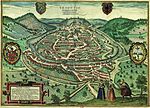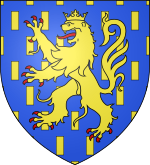Siege of Besançon

The siege of Besançon took place from 25 April to 22 May 1674 during the Franco-Dutch War, when French forces nominally led by Louis XIV of France invaded Franche-Comté, then part of the Spanish Empire. Siege works were supervised by the duc d'Enghien, eldest son of le Grand Condé, and French military engineer Sébastien Le Prestre de Vauban. The defenders were commanded by Vaudémont but the town's isolated position meant they could only delay capture. The bulk of French casualties were caused by a botched assault, allegedly launched to impress Louis, before the garrison surrendered and were allowed free passage to the Spanish Netherlands. Under the 1678 Treaties of Nijmegen, the province was annexed by France and Besançon replaced Dole as the regional capital.
Excerpt from the Wikipedia article Siege of Besançon (License: CC BY-SA 3.0, Authors, Images).Siege of Besançon
Rue du Petit Battant, Besançon Rue Battant
Geographical coordinates (GPS) Address Nearby Places Show on map
Geographical coordinates (GPS)
| Latitude | Longitude |
|---|---|
| N 47.2431 ° | E 6.0219 ° |
Address
Rue du Petit Battant 9 bis
25000 Besançon, Rue Battant
Bourgogne-Franche-Comté, France
Open on Google Maps









